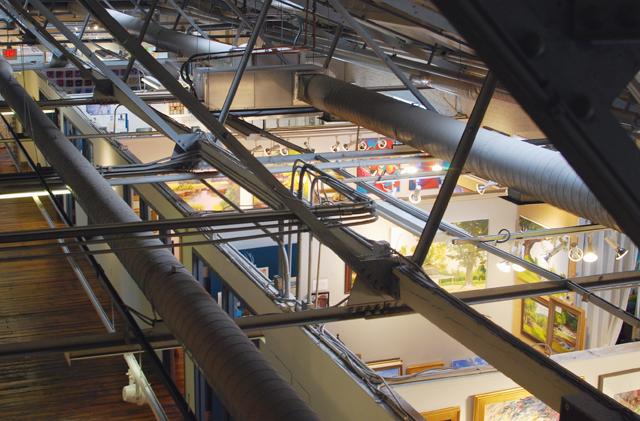
© 2011 NCSU Student Media
Artspace is a gallery in the downtown Raleigh City Market district with over 100 associated members. The gallery is offering its studios and resources to talented local artists. Photo by Sarah Tudor
One of the hardest things students have to deal with after graduation is getting a job, especially in fields like the fine arts where many professionals do not have steady jobs with a company, but rather work on commission. It can be tricky for emerging artists who have recently graduated to market themselves to the art community without a little extra help.
Artspace gallery in downtown Raleigh created the Regional Emerging Artist Residency program in 2000 to help local artists become recognized in North Carolina’s art scene.
“It’s personally one of my favorite programs because it’s a great way to support up-and-coming artists and to provide them space and time to work,” Mary Poole, executive director of Artspace, said.
The gallery supports two resident artists a year for a six-month duration in which the artists get free 24-hour access to Artspace studios. They must also work for at least 15 hours a week during Artspace business hours, particularly during scheduled tours.
The program was started in January of 2000 as a way to support and inspire emerging artists in the Raleigh area. According to Poole, it came from a desire “…to create ways to support artists in the community and not just professional artists.”
Poole talked about a few of the requirements for eligibility for the program. Some of these include: NC residency, no current enrollment in an academic program and being 18 years of age or older. These requirements are available in detail at Artspace’s website.
According to Poole, the process to apply is simple. Applicants must submit digital images of their work as well as a statement that discusses their work and how the residency will benefit their career, which is a factor in how applicants are chosen.
“It’s a review process by committee and then…we typically narrow it down to a few and then do interviews,” Poole said.
“They get exposure to the community just by having the studio space,” Poole said.
Several University alumni have successfully gone through the residency with huge benefits to their careers in the art world.
Luke Buchanan, a 2002 graduate in architecture, did his residency during the fall of 2003, focusing on painting. He said that after he graduated, he needed studio space in order to paint.
“When I graduated I no longer had a studio space and it was kind of difficult to paint in my apartment,” Buchanan said.
One of the things Buchanan said he learned from his residency experience is how to market himself and his artwork, which he said he picked up from the professional artists he worked beside.
“I learned some things about getting into galleries and applying for juried shows and things like that,” he said. “I didn’t really learn that kind of stuff at school.”
He also said that he made many contacts throughout the residency that have continued to benefit him years later.
“It really jump started my presence in the local art scene,” Buchanan said. “There are…contacts that I made that I still benefit from.”
Marie Cordella, a 2008 graduate with a master’s in industrial design, works with textiles as well as in graphic design. She explained that after graduating she was not quite sure what to do next.
“I had just graduated and I didn’t know what to do,” Cordella said. “And I’m really project oriented. I thought it would be beneficial to spend 6 months with those people learning about myself and being watched.”
Through the program, Cordella said she learned a lot about her work habits and that it helped her to decide where she wanted to work in the future.
“I learned that I work better alone. I’m a high energy person, but I don’t talk when I’m working,” she said. “It helped me learn that I wanted to work for myself instead of working inside of a large company.”
She also explained that she learned how to price and sell her work, dividing her studio time between making personal art and commercial works.
“They ask you to create something to sell,” she said. “It taught me a lot about pricing and selling.”
Poole said the program is extremely beneficial for emerging artists, not only to get their work recognized in the community, but to also develop their craft and grow as an artist.
“I think it’s a great opportunity to have a concentrated focused time to work, to develop ideas, to get feedback from professional artists and also to get experience with talking about their work which is extremely important,” Poole said.
Considering the economic climate for graduates of any field, Buchanan and Cordella said they would recommend the program to other young artists.
“You just can’t match the exposure,” Buchanan said. “People come through there for not just First Friday but every day.”
Cordella said she believes her experience got her a head start with her art career and pursuing her future goals.
“I think if you are serious about whatever you are doing, practicing it within your community is the way to go,” Cordella said.